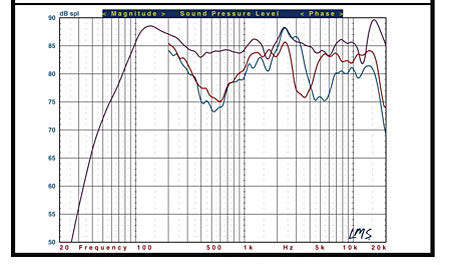PSB VisionSound Series VS400/VS300 Surround Speaker System Measurements
The VS400's ported enclosure is tuned to approximately 46Hz, with a minimum impedance of 4.5Ω also at 46Hz. The measurements suggest that the speaker's nominal impedance is 6Ω, as specified. Its impedance phase angle is benign.
The measurements indicate a sensitivity of about 85dB/2.83V/m. This is well below average and while the VS400's impedance suggests it is an easy load to drive, its low sensitivity does require a reasonably powerful amplifier. The Arcam AV receiver used for the review is rated at 100Wpc, all channels driven, into 8Ω.
The horizontal front response of the VS400 shown in Fig.1 (violet) is the pseudo-anechoic response averaged over a 30° forward horizontal angle, taken at tweeter height, combined with the nearfield responses of the woofer and port. Note that while the averaged front response is relatively linear, there is a plateau between 2kHz and 6kHz averaging +1.5-2.0dB. The off-axis response also shows a peak at about 4.5kHz. While not shown here, the grille does reduce the plateau noticeably, though at the cost of somewhat more uneven response elsewhere, particularly at higher frequencies.

Fig.1: VS400, pseudo-anechoic response at 45° (red) and 60° (blue) off-axis in the horizontal plane.
The effective lower limit of the VS400's response is about 58Hz (-10dB). The VS400 is definitely designed for use with a subwoofer.
Fig.2 shows the same averaged horizontal front response (purple), this time overlaid with the vertical responses taken at +15° (red) and –15° (blue). These curves suggest that the vertical position of your ear should be as close to the center of the tweeter as possible for flattest response.

Fig.2: VS400, pseudo-anechoic response at 15° above (red) and 15° below (blue) the tweeter axis.
The VS300 center channel's ported cabinet is tuned to about 50Hz—if you look at the impedance curve as indicative of a ported enclosure. But the measurements also show that the port is relatively ineffective, with the curve more closely resembling a sealed box with a tuning of 100Hz. Its minimum impedance measured 4.08Ω at 198Hz. I would rate its nominal impedance at 6Ω. Like the VS400, its sensitivity is low at approximately 85dB/2.83V/m. As with the VS400, it should be an easy load to drive apart from its low sensitivity. Its effective bass response extends to about 62Hz (-10dB).
The measured front horizontal response of the VS300, taken on the tweeter axis and averaged in the same manner as described above for the VS400, is shown in Fig.3 (violet curve). As with the VS400, the VS300 is designed for use with a subwoofer for full-range response.

Fig.3: VS300, pseudo-anechoic response at 45° (red) and 60° (blue) off-axis in the horizontal plane.
The VS300's on-axis response, shown here with the On-Wall switch set to Normal, is less smooth than that of the VS400, with a 3dB peak at about 2.3kHz (close to the specified crossover at 2.5kHz) replacing the plateau in the larger speaker. The On-Wall switch adds a peak centered at about 650Hz. As noted in the review, this is designed to compensate for a dip in the response when the speaker is mounted on the wall. Adding the grille (not shown) does change the response, but it is less obvious here than with the VS400 that the change is a net improvement. The grille reduces the peak at 2.3kHz but deepens the dip around 1.5kHz.
The off-axis response of the VS300, also shown in Fig.3, shows the typical comb-filtering suckouts that we've found in all horizontally configured, woofer-tweeter-woofer, center channel speakers. I'd recommend not sitting too far off center with such designs.
Fig.4 shows the vertical response of the VS300 at + 15° (red) and –15° (blue), again overlaid with the averaged front horizontal response. The vertical position of the listener is not critical, within reason.

Fig.4: VS300, pseudo-anechoic response at 15° above (red) and 15° below (blue) the tweeter axis.
This is a respectable set of measurements, apart from the usual off-axis issues with a two-way, horizontal center channel speaker. TJN
All figures: Violet curve: pseudo-anechoic response on the front axis, averaged across a 30° horizontal window, combined with nearfield responses of the woofers and port. All measurements were taken at one meter.
- Log in or register to post comments




































































